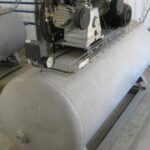A 4-bit comparator is an electronic circuit that compares two 4-bit binary numbers to determine their relationship. Explore the functionalities, applications, and advantages of 4-bit comparators in digital electronics with COMPARE.EDU.VN, ensuring comprehensive insights. Find a perfect match and make informed decisions using magnitude comparators, digital comparators, and logic gates.
1. Understanding Magnitude Comparators
1.1. What is a Magnitude Comparator?
A magnitude comparator is a digital combinational circuit that compares two binary numbers to determine if one number is greater than, less than, or equal to the other. It is a fundamental component in digital systems, crucial for decision-making and control processes. Magnitude comparators are integral to various electronic devices and systems. COMPARE.EDU.VN offers comprehensive guides to grasp these concepts effectively.
1.2. How Does a Magnitude Comparator Work?
A magnitude comparator operates by comparing the binary digits (bits) of two input numbers. Starting from the most significant bit (MSB) to the least significant bit (LSB), the comparator checks for differences. If it finds a bit in one number that is greater than the corresponding bit in the other number, it sets the appropriate output (A > B or A < B). If all bits are identical, it indicates equality (A = B). The working principle of these comparators is detailed further at COMPARE.EDU.VN.
1.3. Key Applications of Magnitude Comparators
Magnitude comparators are used extensively in CPUs, microcontrollers, and various control systems. They are essential in:
- Sorting Algorithms: Determining the order of elements in a dataset.
- Process Controllers: Comparing physical variables with reference values.
- Servo Motor Control: Ensuring precise positioning.
- Password Verification: Matching input passwords with stored values.
- Biometric Applications: Comparing biometric data for authentication.
These practical applications highlight the versatility and importance, which are explained in-depth at COMPARE.EDU.VN.
2. Diving Deep into 4-Bit Comparators
2.1. What is a 4-Bit Comparator?
A 4-bit comparator is a specific type of magnitude comparator designed to compare two 4-bit binary numbers. It has eight inputs (four bits for each number) and three outputs (A > B, A < B, A = B). This comparator determines the relationship between the two 4-bit inputs and asserts the corresponding output. To fully understand the nuances of 4-bit comparators, explore the resources available at COMPARE.EDU.VN.
2.2. Truth Table and Logic Expressions for a 4-Bit Comparator
The behavior of a 4-bit comparator can be described using Boolean expressions, derived from the logical conditions for each output:
- A > B: This condition is met if, at any bit position, A has a 1 while B has a 0, and all higher significant bits are equal.
- A < B: This condition is met if, at any bit position, A has a 0 while B has a 1, and all higher significant bits are equal.
- A = B: This condition is met only when all corresponding bits of A and B are equal.
The logical expressions for each output are:
- A > B: A3B3’ + (A3 ⊕ B3)A2B2’ + (A3 ⊕ B3)(A2 ⊕ B2)A1B1’ + (A3 ⊕ B3)(A2 ⊕ B2)(A1 ⊕ B1)A0B0’
- A < B: A3’B3 + (A3 ⊕ B3)A2’B2 + (A3 ⊕ B3)(A2 ⊕ B2)A1’B1 + (A3 ⊕ B3)(A2 ⊕ B2)(A1 ⊕ B1)A0’B0
- A = B: (A3 ⊙ B3)(A2 ⊙ B2)(A1 ⊙ B1)(A0 ⊙ B0)
Where:
- ⊕ represents the XOR (Exclusive OR) operation.
- ⊙ represents the XNOR (Exclusive NOR) operation.
Visual representation of a 4-bit magnitude comparator circuit.
2.3. Constructing a 4-Bit Comparator Circuit
A 4-bit comparator circuit can be constructed using XOR, XNOR, AND, and OR gates based on the logical expressions. The circuit typically involves several layers of logic gates to compare each bit position and combine the results. Simulation tools like Logisim or Multisim can be used to design and test the circuit. COMPARE.EDU.VN provides detailed schematics and simulation tutorials for building your own 4-bit comparator.
3. Advantages and Disadvantages of 4-Bit Comparators
3.1. Advantages
- Simplicity: Relatively simple to design and implement.
- Efficiency: Provides quick and accurate comparisons for 4-bit numbers.
- Integration: Easily integrated into larger digital systems.
- Speed: Offers fast decision-making capabilities in digital circuits.
Explore how these advantages make 4-bit comparators a practical choice in various digital systems with resources at COMPARE.EDU.VN.
3.2. Disadvantages
- Limited Bit Width: Only compares 4-bit numbers directly.
- Complexity for Larger Numbers: Requires cascading multiple comparators, increasing complexity and cost.
- Power Consumption: Increases with the complexity of the circuit, especially when cascading comparators.
Understand the trade-offs involved when using 4-bit comparators in different applications, with comprehensive comparisons available at COMPARE.EDU.VN.
4. Cascading Comparators for Larger Bit Widths
4.1. What is Cascading?
Cascading is a technique used to expand the bit-width comparison capability by connecting multiple comparators. For example, to compare two 8-bit numbers, two 4-bit comparators can be cascaded. The outputs of the lower-order comparator are connected to the corresponding inputs of the higher-order comparator. This method extends the comparator’s ability to handle larger binary numbers. Discover effective cascading strategies and their applications at COMPARE.EDU.VN.
4.2. How to Cascade 4-Bit Comparators
To cascade two 4-bit comparators:
-
Connect the four least significant bits (LSB) of both 8-bit numbers to the first 4-bit comparator.
-
Connect the four most significant bits (MSB) of both 8-bit numbers to the second 4-bit comparator.
-
Use the A=B output of the first comparator as an enable signal for the second comparator.
-
Combine the outputs of both comparators to determine the final result:
- If the first comparator outputs A > B or A < B, those outputs are the final results.
- If the first comparator outputs A = B, then the outputs of the second comparator become the final results.
Cascading configurations, logic diagrams, and practical examples can be found at COMPARE.EDU.VN.
4.3. Advantages and Disadvantages of Cascading
Advantages:
- Scalability: Allows comparison of binary numbers with virtually any bit width.
- Modularity: Uses identical 4-bit comparator modules, simplifying design and maintenance.
Disadvantages:
- Increased Complexity: Adds more components and connections, increasing the potential for errors.
- Propagation Delay: Introduces additional delay due to the series connection of comparators.
Explore best practices for cascading comparators, optimizing performance, and minimizing complexity at COMPARE.EDU.VN.
5. Comparing 4-Bit Comparators with Other Types
5.1. 1-Bit Comparator
A 1-bit comparator compares two single bits and produces three outputs: A > B, A < B, and A = B. It is simpler than a 4-bit comparator but has limited functionality.
Truth Table for a 1-Bit Comparator:
| A | B | A > B | A = B | A < B |
|---|---|---|---|---|
| 0 | 0 | 0 | 1 | 0 |
| 0 | 1 | 0 | 0 | 1 |
| 1 | 0 | 1 | 0 | 0 |
| 1 | 1 | 0 | 1 | 0 |
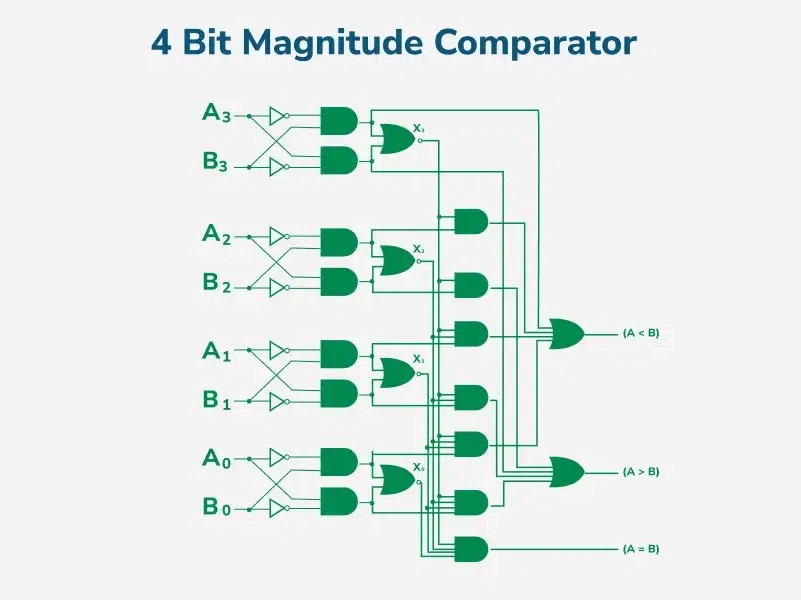
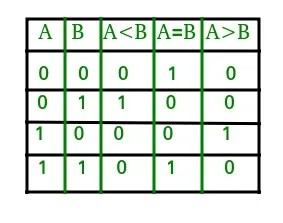
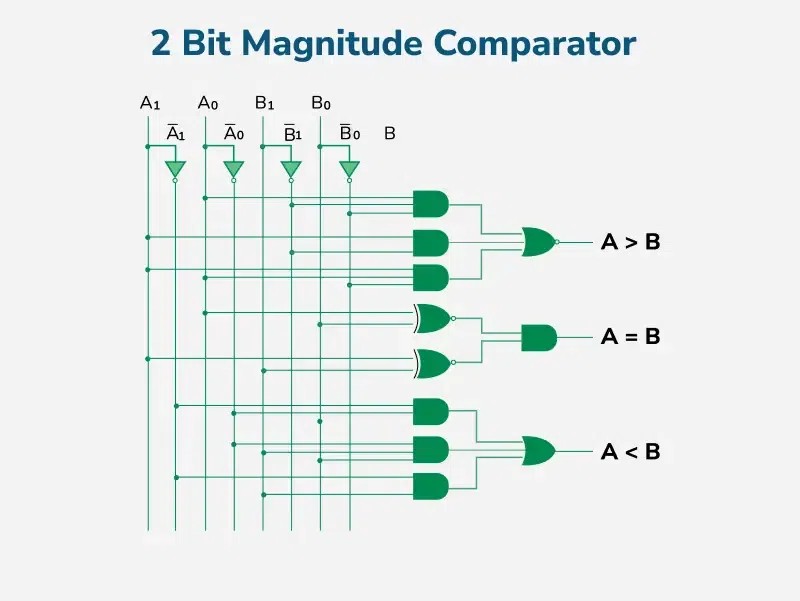
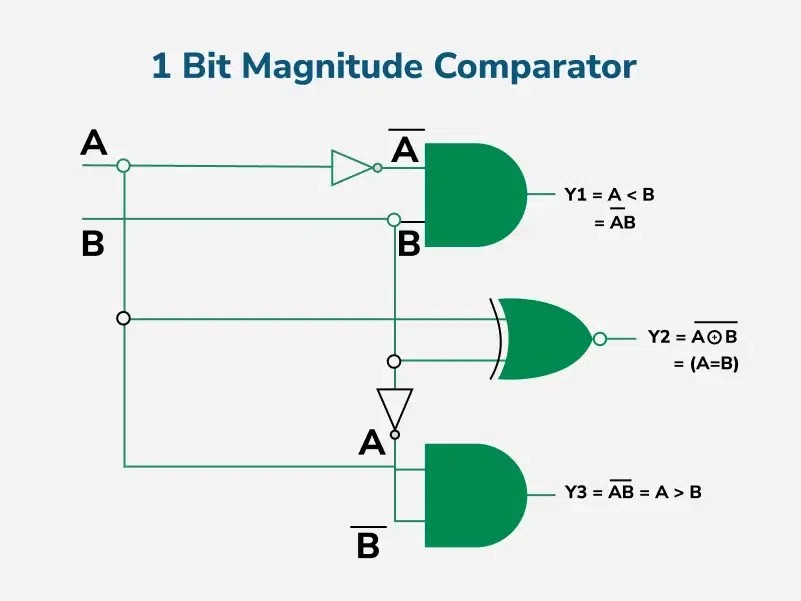
- Schematic of a 1-bit comparator*
Advantages:
- Very simple and easy to implement.
Disadvantages:
- Limited to comparing single bits.
- Not suitable for comparing larger binary numbers without cascading.
5.2. 2-Bit Comparator
A 2-bit comparator compares two 2-bit binary numbers, producing the same three outputs as the 1-bit and 4-bit comparators: A > B, A < B, and A = B.
Truth Table for a 2-Bit Comparator:
| A1 | A0 | B1 | B0 | A > B | A = B | A < B |
|---|---|---|---|---|---|---|
| 0 | 0 | 0 | 0 | 0 | 1 | 0 |
| 0 | 0 | 0 | 1 | 0 | 0 | 1 |
| 0 | 0 | 1 | 0 | 0 | 0 | 1 |
| 0 | 0 | 1 | 1 | 0 | 0 | 1 |
| 0 | 1 | 0 | 0 | 1 | 0 | 0 |
| 0 | 1 | 0 | 1 | 0 | 1 | 0 |
| 0 | 1 | 1 | 0 | 0 | 0 | 1 |
| 0 | 1 | 1 | 1 | 0 | 0 | 1 |
| 1 | 0 | 0 | 0 | 1 | 0 | 0 |
| 1 | 0 | 0 | 1 | 1 | 0 | 0 |
| 1 | 0 | 1 | 0 | 0 | 1 | 0 |
| 1 | 0 | 1 | 1 | 0 | 0 | 1 |
| 1 | 1 | 0 | 0 | 1 | 0 | 0 |
| 1 | 1 | 0 | 1 | 1 | 0 | 0 |
| 1 | 1 | 1 | 0 | 1 | 0 | 0 |
| 1 | 1 | 1 | 1 | 0 | 1 | 0 |
- Logic circuit for a 2-bit comparator*
Advantages:
- Suitable for comparing 2-bit numbers with reasonable complexity.
Disadvantages:
- More complex than a 1-bit comparator.
- Limited to comparing 2-bit numbers without cascading.
5.3. N-Bit Comparator
An n-bit comparator is a generalized version that can compare two n-bit binary numbers. It can be implemented using a combination of logic gates or by cascading smaller comparators.
Advantages:
- Versatile and can handle any bit width through cascading.
Disadvantages:
- Higher complexity and cost for larger bit widths.
- Increased propagation delay due to cascading.
Explore detailed comparisons of different comparator types, including performance metrics, cost considerations, and suitability for various applications, at COMPARE.EDU.VN.
6. Logic Gates Used in 4-Bit Comparators
6.1. XOR Gate
The XOR (Exclusive OR) gate outputs a high signal (1) only when the inputs are different. It is crucial for comparing individual bits in a comparator circuit.
Truth Table for XOR Gate:
| A | B | Output |
|---|---|---|
| 0 | 0 | 0 |
| 0 | 1 | 1 |
| 1 | 0 | 1 |
| 1 | 1 | 0 |
6.2. XNOR Gate
The XNOR (Exclusive NOR) gate outputs a high signal (1) only when the inputs are the same. It is used to determine equality between bits.
Truth Table for XNOR Gate:
| A | B | Output |
|---|---|---|
| 0 | 0 | 1 |
| 0 | 1 | 0 |
| 1 | 0 | 0 |
| 1 | 1 | 1 |
6.3. AND Gate
The AND gate outputs a high signal (1) only when all inputs are high (1). It is used to combine comparison results from different bit positions.
Truth Table for AND Gate:
| A | B | Output |
|---|---|---|
| 0 | 0 | 0 |
| 0 | 1 | 0 |
| 1 | 0 | 0 |
| 1 | 1 | 1 |
6.4. OR Gate
The OR gate outputs a high signal (1) if at least one input is high (1). It is used to combine the results of multiple comparisons to determine the overall outcome.
Truth Table for OR Gate:
| A | B | Output |
|---|---|---|
| 0 | 0 | 0 |
| 0 | 1 | 1 |
| 1 | 0 | 1 |
| 1 | 1 | 1 |
A comprehensive guide to logic gates, including their functionalities, applications, and truth tables, is available at COMPARE.EDU.VN.
7. Common Issues and Troubleshooting
7.1. Incorrect Output
If the comparator produces an incorrect output, check the following:
- Wiring Errors: Ensure all connections are correct, especially the inputs and outputs of the logic gates.
- Logic Gate Functionality: Verify that all logic gates are functioning correctly.
- Input Signals: Check that the input signals are stable and within the expected voltage levels.
7.2. Propagation Delay
Propagation delay can cause timing issues, especially in cascaded comparators. To minimize propagation delay:
- Use Faster Logic Gates: Employ logic gates with shorter propagation delays.
- Optimize Circuit Layout: Reduce the length of signal paths to minimize delays.
7.3. Power Supply Issues
Insufficient or unstable power supply can cause erratic behavior. Ensure that the power supply is adequate and stable.
Troubleshooting guides, common error solutions, and best practices for maintaining 4-bit comparators are available at COMPARE.EDU.VN.
8. Real-World Applications and Examples
8.1. Use in Central Processing Units (CPUs)
Comparators are critical components in CPUs for performing a variety of functions. For instance, they are used to determine if a value stored in a register is greater than, less than, or equal to another value, which is essential for conditional branching in programs.
Example:
Consider a CPU executing a simple program:
LOAD R1, 10 ; Load the value 10 into register R1
LOAD R2, 5 ; Load the value 5 into register R2
CMP R1, R2 ; Compare the values in R1 and R2
JG Label ; Jump to Label if R1 > R2
; Some other code
Label:
; Code to execute if R1 > R2In this case, the CMP (compare) instruction uses a comparator to determine the relationship between the values in R1 and R2. If R1 is greater than R2, the JG (jump if greater) instruction causes the program to jump to the Label.
8.2. Microcontrollers in Embedded Systems
Microcontrollers use comparators for real-time control and decision-making. They are often used to compare sensor readings against predefined thresholds.
Example:
In a temperature control system, a microcontroller monitors the temperature using a temperature sensor.
int temperature = readTemperatureSensor(); // Function to read temperature
int threshold = 25; // Temperature threshold in Celsius
if (temperature > threshold) {
activateCoolingSystem(); // Function to turn on the cooling system
} else {
deactivateCoolingSystem(); // Function to turn off the cooling system
}Here, a comparator within the microcontroller determines if the current temperature exceeds the threshold.
8.3. Servo Motor Control
Servo motors require precise control to position a shaft at a specific angle. Comparators play a key role in these control systems.
Example:
A servo motor control system uses a potentiometer to read the current position of the motor shaft. A comparator compares this position with a desired position set by the user.
int desiredPosition = readDesiredPosition(); // Read the desired position
int currentPosition = readCurrentPosition(); // Read the current position
if (currentPosition < desiredPosition) {
rotateClockwise(); // Function to rotate the motor clockwise
} else if (currentPosition > desiredPosition) {
rotateCounterClockwise(); // Function to rotate the motor counter-clockwise
} else {
stopMotor(); // Function to stop the motor
}The comparator ensures that the motor rotates until the current position matches the desired position.
8.4. Password Verification
Comparators are used to verify passwords by comparing the entered password with a stored password.
Example:
In a login system, the entered password is compared against the stored password.
enteredPassword = input("Enter your password: ")
storedPassword = getStoredPassword(username) # Function to retrieve stored password
if (enteredPassword == storedPassword):
grantAccess(username) # Function to allow access
else:
denyAccess(username) # Function to deny accessA comparator ensures that the entered password matches the stored password exactly.
8.5. Biometric Applications
Biometric systems use comparators to match biometric data, such as fingerprints or facial features, for authentication.
Example:
In a fingerprint scanning system, the scanned fingerprint is compared with stored fingerprint data.
scannedFingerprint = scanFingerprint(); // Function to scan the fingerprint
storedFingerprint = getStoredFingerprint(user_id); // Function to retrieve stored fingerprint
if (compareFingerprints(scannedFingerprint, storedFingerprint)): // Compare fingerprints
allowAccess(user_id); // Function to grant access
else:
denyAccess(user_id); // Function to deny accessThe comparator ensures that the scanned fingerprint matches the stored fingerprint with a high degree of accuracy.
9. Future Trends in Comparator Technology
9.1. Low-Power Comparators
With the increasing demand for energy-efficient devices, low-power comparators are becoming increasingly important. These comparators are designed to minimize power consumption, making them suitable for portable devices and battery-powered applications.
9.2. High-Speed Comparators
High-speed comparators are crucial for applications that require fast decision-making, such as high-frequency data acquisition systems and communication networks. These comparators use advanced circuit designs and fabrication techniques to achieve very short propagation delays.
9.3. Integrated Comparators
Integrated comparators combine multiple functions into a single chip, reducing the size and complexity of electronic systems. These integrated solutions often include additional features such as voltage references and hysteresis control.
9.4. Adaptive Comparators
Adaptive comparators can adjust their performance characteristics based on the input signal and operating conditions. This allows them to optimize performance in a wide range of applications.
9.5. Comparators in AI and Machine Learning
Comparators are being used in AI and machine learning applications to implement decision-making logic and perform comparisons in neural networks.
10. Frequently Asked Questions (FAQ)
Q1: What is the primary function of a 4-bit comparator?
A 4-bit comparator compares two 4-bit binary numbers to determine if one is greater than, less than, or equal to the other.
Q2: How many inputs and outputs does a 4-bit comparator have?
A 4-bit comparator has eight inputs (four for each binary number) and three outputs (A > B, A < B, A = B).
Q3: What logic gates are commonly used in a 4-bit comparator?
XOR, XNOR, AND, and OR gates are commonly used to implement the comparison logic.
Q4: Can 4-bit comparators be used to compare numbers larger than 4 bits?
Yes, by cascading multiple 4-bit comparators.
Q5: What is cascading in the context of comparators?
Cascading is a technique to expand the bit-width comparison capability by connecting multiple comparators.
Q6: What are the advantages of using a 4-bit comparator?
Simplicity, efficiency, easy integration, and fast decision-making.
Q7: What are the disadvantages of using a 4-bit comparator?
Limited bit width, complexity for larger numbers, and increased power consumption with cascading.
Q8: How can propagation delay be minimized in a 4-bit comparator circuit?
Using faster logic gates and optimizing the circuit layout.
Q9: What are some real-world applications of comparators?
CPUs, microcontrollers, servo motor control, password verification, and biometric applications.
Q10: What is the difference between an XOR gate and an XNOR gate?
An XOR gate outputs a high signal (1) when the inputs are different, while an XNOR gate outputs a high signal (1) when the inputs are the same.
Visual representation of a 1-bit magnitude comparator circuit.
Conclusion
4-bit comparators are essential components in digital logic systems, facilitating the comparison of binary numbers. Their simplicity and efficiency make them ideal for various applications, though dealing with larger bit widths and power consumption can pose challenges. For more in-depth comparisons and resources, visit COMPARE.EDU.VN.
Ready to explore more comparisons and make informed decisions? Visit COMPARE.EDU.VN today and discover the best solutions for your needs. Our comprehensive comparisons provide you with the insights you need to make smart choices. Contact us at:
Address: 333 Comparison Plaza, Choice City, CA 90210, United States
WhatsApp: +1 (626) 555-9090
Website: compare.edu.vn
